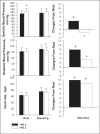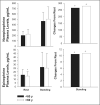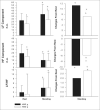Attenuation of autonomic nervous system functions in hypertensive patients at rest and during orthostatic stimulation
- PMID: 18256574
- PMCID: PMC8109863
- DOI: 10.1111/j.1751-7176.2008.07324.x
Attenuation of autonomic nervous system functions in hypertensive patients at rest and during orthostatic stimulation
Abstract
The effect of age on autonomic nervous system was assessed at rest and while standing using systolic blood pressure (SBP) and diastolic blood pressure (DBP), heart rate, and power spectral analysis of the time duration between 2 consecutive R waves of an electrocardiogram (RR) interval variability, as well as on plasma norepinephrine and epinephrine levels in mild to moderate hypertensive patients (DBP, 90-110 mm Hg). Patients younger than 60 years (n=57) and older than 60 years (n=32), were evaluated after a 3- to 4-week placebo period. Plasma catecholamines were measured in the supine position at rest and after 10 minutes of standing. Power spectral analysis of the RR interval variability was performed in each condition using the high-frequency (HF) band (0.15-0.4 Hz) as an index of parasympathetic activity and the low-frequency (LF) band (0.05-0.15 Hz) and LF-HF ratio to estimate sympathetic activity. The total power was calculated as the sum of LF and HF power. supine SBP was significantly higher in older patients (P<.05). SBP and DBP increased significantly only in younger patients during standing (P<.05), while the changes were smaller and nonsignificantly lower in older patients. HR was similar in both groups at rest and increased similarly during standing. Norepinephrine and epinephrine levels were similar at rest and increased similarly in both groups of patients during standing. At rest, lower LF and HF components were observed in older patients. The LF component increased less and the HF component decreased less in older patients during standing. A lower sympathetic and parasympathetic basal cardiac tone was observed at rest in older hypertensive patients. Moreover, reduced hemodynamic and sympathetic responses to standing as assessed by SBP, DBP, and the LF component of HR variability were observed in older hypertensives in the presence of a normal catecholamine response. These observations could reflect a decreased sensitivity of cardiac beta-adrenoceptors with aging.
Figures




Similar articles
-
Blood pressure, heart rate, and plasma catecholamines in normal and hypertensive children and their siblings at rest and after standing.Hypertension. 1982 Jul-Aug;4(4):507-13. doi: 10.1161/01.hyp.4.4.507. Hypertension. 1982. PMID: 7152630
-
Autonomic nervous system function in adolescent migraineurs.Pediatr Int. 2017 Sep;59(9):991-995. doi: 10.1111/ped.13342. Pediatr Int. 2017. PMID: 28612516
-
[Study of the autonomous nervous system with heart rate spectral analysis in acute myocardial infarction].Rev Port Cardiol. 1991 Dec;10(12):923-9. Rev Port Cardiol. 1991. PMID: 1807298 Portuguese.
-
Renin-angiotensin-aldosterone system, RR interval, and blood pressure variability during postural changes in borderline arterial hypertension.Am J Hypertens. 1995 Jul;8(7):683-8. doi: 10.1016/0895-7061(95)00080-9. Am J Hypertens. 1995. PMID: 7546493 Clinical Trial.
-
Heart rate variability and autonomic activity at rest and during exercise in various physiological conditions.Eur J Appl Physiol. 2003 Oct;90(3-4):317-25. doi: 10.1007/s00421-003-0953-9. Epub 2003 Sep 12. Eur J Appl Physiol. 2003. PMID: 13680241 Review.
Cited by
-
Low-frequency power of heart rate variability is not a measure of cardiac sympathetic tone but may be a measure of modulation of cardiac autonomic outflows by baroreflexes.Exp Physiol. 2011 Dec;96(12):1255-61. doi: 10.1113/expphysiol.2010.056259. Epub 2011 Sep 2. Exp Physiol. 2011. PMID: 21890520 Free PMC article. Review.
-
Autonomic dysfunction in COVID-19 patients receiving mechanical ventilation: A cross-sectional study.Sao Paulo Med J. 2023 Apr 17;141(6):e2022513. doi: 10.1590/1516-3180.2022.0513.R1.09022023. eCollection 2023. Sao Paulo Med J. 2023. PMID: 37075456 Free PMC article.
-
Role of the autonomic nervous system in young, middle-aged, and older individuals with essential hypertension and sleep-related changes in neurocardiac regulation.Sci Rep. 2023 Dec 18;13(1):22623. doi: 10.1038/s41598-023-49649-2. Sci Rep. 2023. PMID: 38114517 Free PMC article.
-
Analysis of autonomic modulation after an acute session of resistance exercise at different intensities in chronic obstructive pulmonary disease patients.Int J Chron Obstruct Pulmon Dis. 2015 Jan 29;10:223-9. doi: 10.2147/COPD.S64345. eCollection 2015. Int J Chron Obstruct Pulmon Dis. 2015. PMID: 25673982 Free PMC article.
-
Different acquisition systems for heart rate variability analysis may lead to diverse outcomes.Braz J Med Biol Res. 2022 Feb 4;55:e11720. doi: 10.1590/1414-431X2021e11720. eCollection 2022. Braz J Med Biol Res. 2022. PMID: 35137854 Free PMC article.
References
-
- Brecht HM, Schoeppe W. Relation of plasma noradrenaline to blood pressure, age, sex and sodium balance in patients with stable essential hypertension and in normotensive subjects. Clin Sci Mol Med Suppl. 1978;4:81s–83s. - PubMed
-
- Chemla D, Hebert JL, Coirault C, et al. Total arterial compliance estimated by stroke volume‐to‐aortic pulse pressure ratio in humans. Am J Physiol. 1998;274:H500–H505. - PubMed
-
- Cleophas TJ, Van Marum R. Age‐related decline in autonomic control of blood pressure: implications for the pharmacological management of hypertension in the elderly. Drugs Aging. 2003;20(5):313–319. - PubMed
-
- De Champlain J, Karas M, Nguyen P, et al. Different effects of nifedipine and amlodipine on circulating catecholamine levels in essential hypertensive patients. J Hypertens. 1998;16:1357–1369. - PubMed
-
- Esler M, Skews H, Leonard P. Age‐dependence of noradrenaline kinetics in normal subjects. Clin Sci (Lond). 1981;60:217–219. - PubMed
Publication types
MeSH terms
Substances
LinkOut - more resources
Full Text Sources
Other Literature Sources
Medical
Research Materials
Miscellaneous

